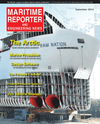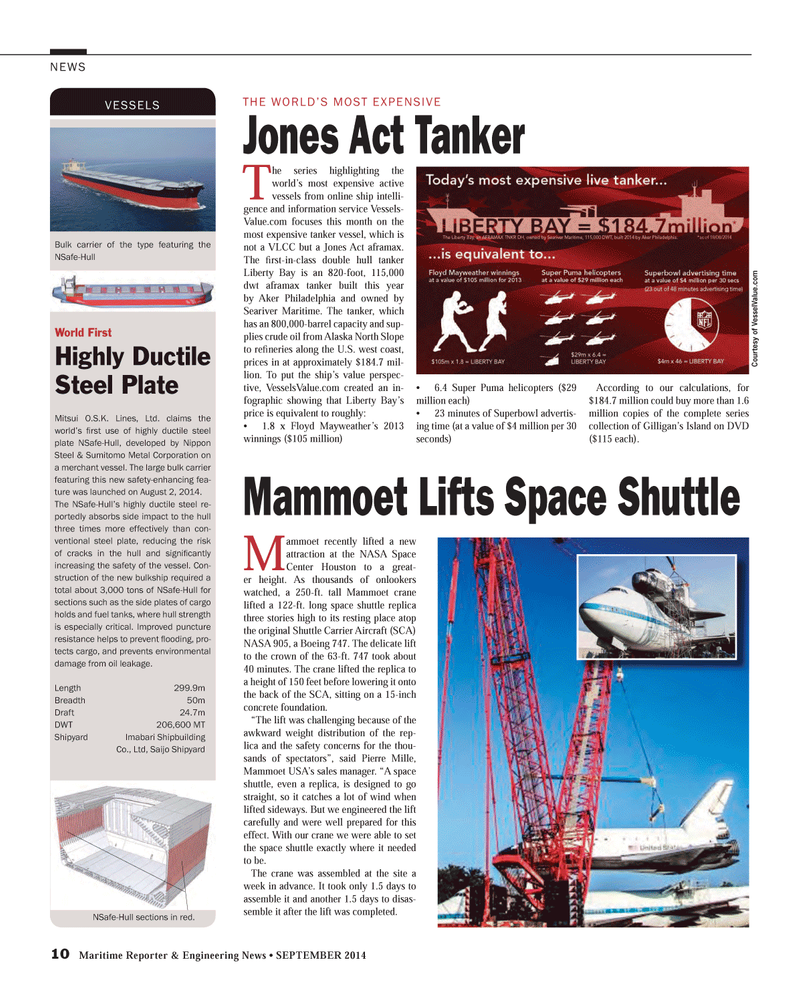
Page 10: of Maritime Reporter Magazine (September 2014)
Marine Propulsion Edition
Read this page in Pdf, Flash or Html5 edition of September 2014 Maritime Reporter Magazine
10 Maritime Reporter & Engineering News • SEPTEMBER 2014
NEWS
M ammoet recently lifted a new attraction at the NASA Space
Center Houston to a great- er height. As thousands of onlookers watched, a 250-ft. tall Mammoet crane lifted a 122-ft. long space shuttle replica three stories high to its resting place atop the original Shuttle Carrier Aircraft (SCA)
NASA 905, a Boeing 747. The delicate lift to the crown of the 63-ft. 747 took about 40 minutes. The crane lifted the replica to a height of 150 feet before lowering it onto the back of the SCA, sitting on a 15-inch concrete foundation. “The lift was challenging because of the awkward weight distribution of the rep- lica and the safety concerns for the thou- sands of spectators”, said Pierre Mille,
Mammoet USA’s sales manager. “A space shuttle, even a replica, is designed to go straight, so it catches a lot of wind when lifted sideways. But we engineered the lift carefully and were well prepared for this effect. With our crane we were able to set the space shuttle exactly where it needed to be.
The crane was assembled at the site a week in advance. It took only 1.5 days to assemble it and another 1.5 days to disas- semble it after the lift was completed.
Bulk carrier of the type featuring the
NSafe-Hull
World First
Highly Ductile
Steel Plate
Mitsui O.S.K. Lines, Ltd. claims the world’s fi rst use of highly ductile steel plate NSafe-Hull, developed by Nippon
Steel & Sumitomo Metal Corporation on a merchant vessel. The large bulk carrier featuring this new safety-enhancing fea- ture was launched on August 2, 2014.
The NSafe-Hull’s highly ductile steel re- portedly absorbs side impact to the hull three times more effectively than con- ventional steel plate, reducing the risk of cracks in the hull and signifi cantly increasing the safety of the vessel. Con- struction of the new bulkship required a total about 3,000 tons of NSafe-Hull for sections such as the side plates of cargo holds and fuel tanks, where hull strength is especially critical. Improved puncture resistance helps to prevent fl ooding, pro- tects cargo, and prevents environmental damage from oil leakage.
Length 299.9m
Breadth 50m
Draft 24.7m
DWT 206,600 MT
Shipyard Imabari Shipbuilding Co., Ltd, Saijo Shipyard
VESSELS
T he series highlighting the world’s most expensive active vessels from online ship intelli- gence and information service Vessels-
Value.com focuses this month on the most expensive tanker vessel, which is not a VLCC but a Jones Act aframax.
The fi rst-in-class double hull tanker
Liberty Bay is an 820-foot, 115,000 dwt aframax tanker built this year by Aker Philadelphia and owned by
Seariver Maritime. The tanker, which has an 800,000-barrel capacity and sup- plies crude oil from Alaska North Slope to refi neries along the U.S. west coast, prices in at approximately $184.7 mil- lion. To put the ship’s value perspec- tive, VesselsValue.com created an in- fographic showing that Liberty Bay’s price is equivalent to roughly: • 1.8 x Floyd Mayweather’s 2013 winnings ($105 million) • 6.4 Super Puma helicopters ($29 million each) • 23 minutes of Superbowl advertis- ing time (at a value of $4 million per 30 seconds)
According to our calculations, for $184.7 million could buy more than 1.6 million copies of the complete series collection of Gilligan’s Island on DVD ($115 each).
Jones Act Tanker
THE WORLD’S MOST EXPENSIVE
Cour tesy of V esselV alue.com
Mammoet Lifts Space Shuttle
NSafe-Hull sections in red.
MR #9 (10-17).indd 10 9/5/2014 8:59:45 AM

 9
9

 11
11
